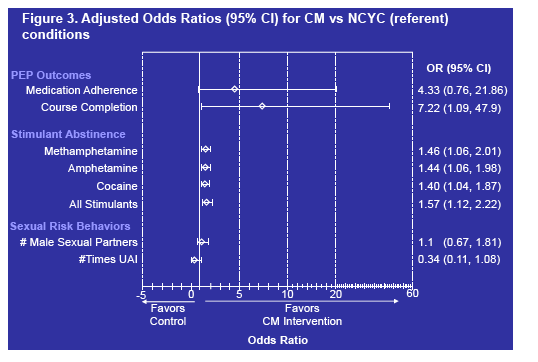 |
 |
 |
| |
Contingency Management Facilitates PEP Completion
among Stimulant-Using MSM
|
| |
| |
Reported by Jules Levin
CROI 2014 March 3-6 Boston, MA
Raphael J. Landovitz*1, Jesse B. Fletcher2, Steve Shoptaw3, Cathy J. Reback2 1University of California, Los Angeles, Center for Clinical AIDS Research & Education, Los Angeles, CA, US; 2Friends Research Institute, Inc. Los Angeles, CA, US; 3University of California, Los Angeles, Department of Family Medicine, Los Angeles, CA, US


Program Abstract-
Background: Post-exposure prophylaxis (PEP) is an emergency chemoprophylactic intervention after an exposure
to viral inoculum. Stimulant-using (SU) MSM are at high risk of HIV acquisition, but are a challenging population in which
to implement PEP. CM is a robust intervention that provides voucherbased
incentives for stimulant-use abstinence, and has been shown to be a powerful and durable substance-use intervention.
We previously reported that in a single-arm pilot intervention of PEP combined with CM in methamphetamine-using MSM,
time to PEP initiation, adherence, and course completion rates were not different from historical non-SU populations.
Methodology: We conducted a prospective, randomized controlled trial of CM with PEP among SU MSM at a single
site in Los Angeles, California. Participants enrolled in the study were randomized to CM or non-contingent (NC)
control behavioral intervention and followed prospectively. Generalized linear models were used to estimate the effect of
CM on likelihood of PEP course completion, rates of medication adherence, stimulant use and self-reported sexual risk behaviors.
All analyses controlled for participant sexual identity, race/ethnicity, housing status, and income.
Results: Between June, 2010 and June, 2012, 140 MSM individuals were enrolled and randomized to CM (n=70)
or a NC (n=70) behavioral intervention. The participants were 37% Caucasian, 37% African American, and 18% Latino.
Mean age was 36.8 (SD 10.2) years, 61% had high school education or less, and 88.4% reported an annual income
²$30,000. 45 participants (32%) initiated PEP after a high-risk sexual exposure during the study period, with
a mean exposure-to-PEP time of 35.2 hours. 29 of the 45 had evaluable adherence data. PEP course completion was
significantly greater in the CM arm compared to the NC arm (AOR 7.2, 95% CI 1.1-47.9), and there was a trend towards
improved medication adherence by self-report in the CM arm (AOR 4.33, 95% CI 0.76-21.86). CM participants had a
greater probability of stimulant-free urine specimens vs. NC participants (IRR 1.57, 95% CI 1.12-2.22), and a trend
towards reduced episodes of UAI (IRR 0.34 [95% CI 0.11-1.08). One HIV seroconversion was observed
in the context of repeat exposures, and is unlikely to represent PEP failure.
Conclusions: In a randomized, controlled trial of SU MSM, CM facilitated the use of PEP by increasing rates of course
completion, and suggesting a trend toward improved adherence. Reductions in sexual risk afforded by the CM intervention
are a prime example of HIV prevention synergy. Despite small numbers of individuals initiating PEP, findings suggest that
CM may be a useful support mechanism for the use of PEP, and potentially other biomedical prophylactic strategies in
stimulant-using MSM.






References
1.Centers for Disease Control and Prevention. Antiretroviral postexposure prophylaxis after sexual, injection drug use, or other nonoccupational exposure to HIV in the United States: Recommendations from the U.S. Department of Health and Human Services. MMWR Recommendations and Reports Vol 54 No. RR-2. 2005.
2.California Task Force on Non-Occupational PEP and the California Department of Health Services Office of AIDS. Offering HIV post-exposure prophylaxis (PEP) following non-occupational exposures: Recommendations for health care providers in the state of California. Sacramento, CA; 2004.
3.World Heatlh Organization. Post-exposure prophylaxis to prevent HIV infection: Joint WHO/ILO guidelines on post-exposure prophylaxis (PEP) to prevent HIV infection. Geneva; 2007.
4.Cardo DM, Culver DH, Ciesielski CA, Srivastava PU, Marcus R, Abiteboul D, et al. A case-control study of HIV seroconversion in health care workers after percutaneous exposure. Centers for Disease Control and Prevention Needlestick Surveillance Group. N Engl J Med. 1997;337(21):1485-90.
5.Division of HIV and STD Programs, Health LACDoP. 2012 Annual HIV Surveillance Report. http://publichealth.lacounty.gov/wwwfiles/ph/hae/hiv/2012AnnualHIVSurveillanceReport.pdf. Published March 2013. Accessed February 25, 2014.
6.Koblin BA, Jusnik MJ, Colfax G, Huang Y, Madison M, Mayer K, et al. Risk factors for HIV infection among men who have sex with men. AIDS. 2006;20:731-9.
7.Ostrow DG, Plankey MW, Cox C, Li X, Shoptaw S, Jacobson LP, et al. Specific sex drug combinations contribute to the majority of recent HIV seroconversions among MSM in the MACS. J Acquir Immune Defic Syndr. 2009;51:349-55.
8.Shoptaw S, Klausner JD, Reback CJ, Tierney S, Stansell J, Hare CB, et al. A public health response to the methamphetamine epidemic: the implementation of contingency management to treat methamphetamine dependence. BMC Public Health. 2006;18(6):214.
9.Reback CJ, Peck JA, Dierst-Davies R, Nuno M, Kamien JB, Amass L. Contingency Management Among Homeless, Out-of-Treatment Men who have Sex with Men. J Subst Abuse Treat. 2010;39:255-63.
10. Landovitz RJ, Fletcher J, Inzhakova G, Lake JE, Shoptaw S, Reback CJ. A novel combination HIV prevention strategy: Postexposure prophylaxis with contingency management for substance abuse treatment among methamphetamine-using men who have sex with men. AIDS Patient Care STDS. 2012;26(6):320-8.
|
| |
|
 |
 |
|
|